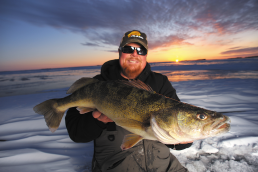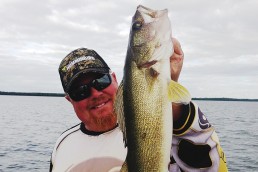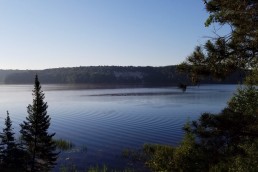Ice-out River Walleyes: Some of the Finest of the Year
SHARE THIS POST
Many states have closed seasons on walleyes to give fish a chance to spawn without any pressure. Some of the border waters around Minnesota have early-spring seasons for walleyes, which is usually when my boat gets wet each spring.
My two favorite locations for ice-out walleyes are the Rainy River bordering Ontario and the Lower Mississippi bordering Wisconsin. The pre-spawn is one of the most active times of the year for walleyes, and one of the best chances for anglers to catch some big fish. Catch and release is critical in spring, though, as these walleyes are getting ready to pay back the lakes for all the food they ate in the past year.
Once a year, walleyes put a deposit back into the lakes when they spawn. By adding another age-class of walleyes to the lakes and rivers, this species is able to flourish into the future.
Many border waters with Minnesota allow anglers to fish walleyes in spring. But there is usually a lower bag limit at this time along with size restrictions to protect the larger females. Pre-spawn female walleyes are in the last stages of gestation when they begin their spawning migrations. They are hungry and need to feed more often to finish off their eggs and provide the extra energy they need to swim against the current to reach their spawning sites.
The Rainy River and the Lower Mississippi River areas have many similarities, but there are also stark differences between the two rivers that affect walleye location and their feeding patterns. Both rivers are negatively impacted by rising water levels from excessive rain and runoff. Both rivers have some natural stain in the water that looks like weak coffee, but they can look like coffee with too much “cream” when the water gets muddy. Stained is good; muddy is bad. Anglers want to fish the rivers before the water gets too dirty. Once they do, the fishing here becomes much more difficult, even though the fish are still there.
Mississippi magic
Fishing on the Lower Mississippi starts much earlier than on the Rainy River, which is “usually” still covered with ice when anglers start open-water fishing on the Lower Mississippi. The Lower Mississippi walleyes are residents of the Mississippi River, and don’t come out of a big lake like most of the Rainy walleyes do, however there are exceptions like Lake Pepin and “Pool 4.”
The Lower Mississippi offers many different types of structure, from the main river channel to secondary river channels, backwater areas off of the main channels and numerous little cuts. These offer walleyes slower currents and more stable water levels to give them just the right conditions to spawn.
Presentations for walleyes in the Lower Mississippi can vary, depending on the type of area. Anglers can fish the main river channel that has wing dams, current seams, log piles or sections of riprap. You can fish the secondary channels, the backwaters that fish like, the small lakes or the little cuts and streams that can have holes and other areas that hold spawning walleyes. I pitch jigs and ringworms or the Northland Impulse Core Swimbait along the sections of riprap or cut banks that have a quick drop-off along the main river channel. Anglers can also troll or use handlines with floating minnow baits in the flat stretches of the main channel or secondary channels. Pulling cranks, stickbaits or jointed minnow baits can also work well.
Are you enjoying this post?
You can be among the first to get the latest info on where to go, what to use and how to use it!
The stained water in both the Lower Mississippi and the Rainy allow anglers to be able to use a little heavier line and still catch plenty of fish. I like10-pound-test Sunline SX 1, or their 10- to 12-pound-test line in their Green with an 8-pound Clear Sunline Shooter Fluorocarbon leader with a small swivel tied above to prevent line twist.
Some other presentations for walleyes include pitching or vertically jigging blade baits or using a three-way swivel with a gumdrop floater and minnow. Or, you can use the three-way to troll the crankbaits. Trolling leadcore is another option for deeper fish.
Rainy wrangling
The Rainy River walleyes are much less complicated; stay on the Minnesota half of the river to avoid license, passport and permit regulations. Virtually all of the fishing is in the main river channel. Most Rainy River ‘eyes come out of Lake of the Woods. There are also some resident fish that spend the summer in the Rainy or up one of the major tributaries like the Little Fork or Big Fork rivers. There are also smaller tributaries that run all the way into lakes north of Deer River and Grand Rapids.
The Rainy is usually best early, before the ice goes out on the Big Fork and Little Fork rivers, which usually muddies up the water. Anglers rush to get their boats into the river as soon as the accesses are clear of ice. Anglers in smaller boats often slide their boats across the ice to get to the water, which is not advised for obvious safety reasons.
Clients that have fished with me know I like to fish jigs whenever possible. My first bait for the Rainy is a Northland RZ Jig tipped with an emerald shiner or a rainbow chub. I’ll then use a heavy jig to stay in good contact with the bottom. And most situations, this means either jigs in 1/4, 3/8 or 1/2 ounce. I thread the minnows on the shaft of the jig, going in the mouth, out the gill and then through the center of the minnow and out the back. The minnow should look like a plastic fluke rigged in a straight line.
For colors, gold and a pink always work in stained water and so will UV jigs. Color matters, so experiment to see what works best. And, “good” bait is important. I keep mine fresh in a Frabill aerated bait container or two.
I like to fish shoreline seams or current breaks in the Rainy. Many of the locals will anchor on key areas and fish vertically below their boats, waiting for the schools of walleyes to pass through the area. I prefer to slowly slide down with the current using my Minn Kota Ulterra to control the drift. I will hit the “spot-lock” feature when I catch a fish or see a group of them on my electronics and pitch jigs across the current and then slowly work them back to the boat.
MWO
SHARE THIS POST
Did you enjoy this post?
You can be among the first to get the latest info on where to go, what to use and how to use it!
Brian 'Bro' Brosdahl
Outdoor communicator Brian “Bro” Brosdahl lives in northern Minnesota. He is a walleye guide in the Cass Lake, Leech Lake and Lake Winnibigoshish areas. He is sponsored by Northland Fishing Tackle, Frabill/Plano, Aqua-Vu, Humminbird/Minn Kota, St. Croix Rods, Ranger Boats, and Evinrude. Guide inquiries: brosguideservice.com. Follow on social media.



